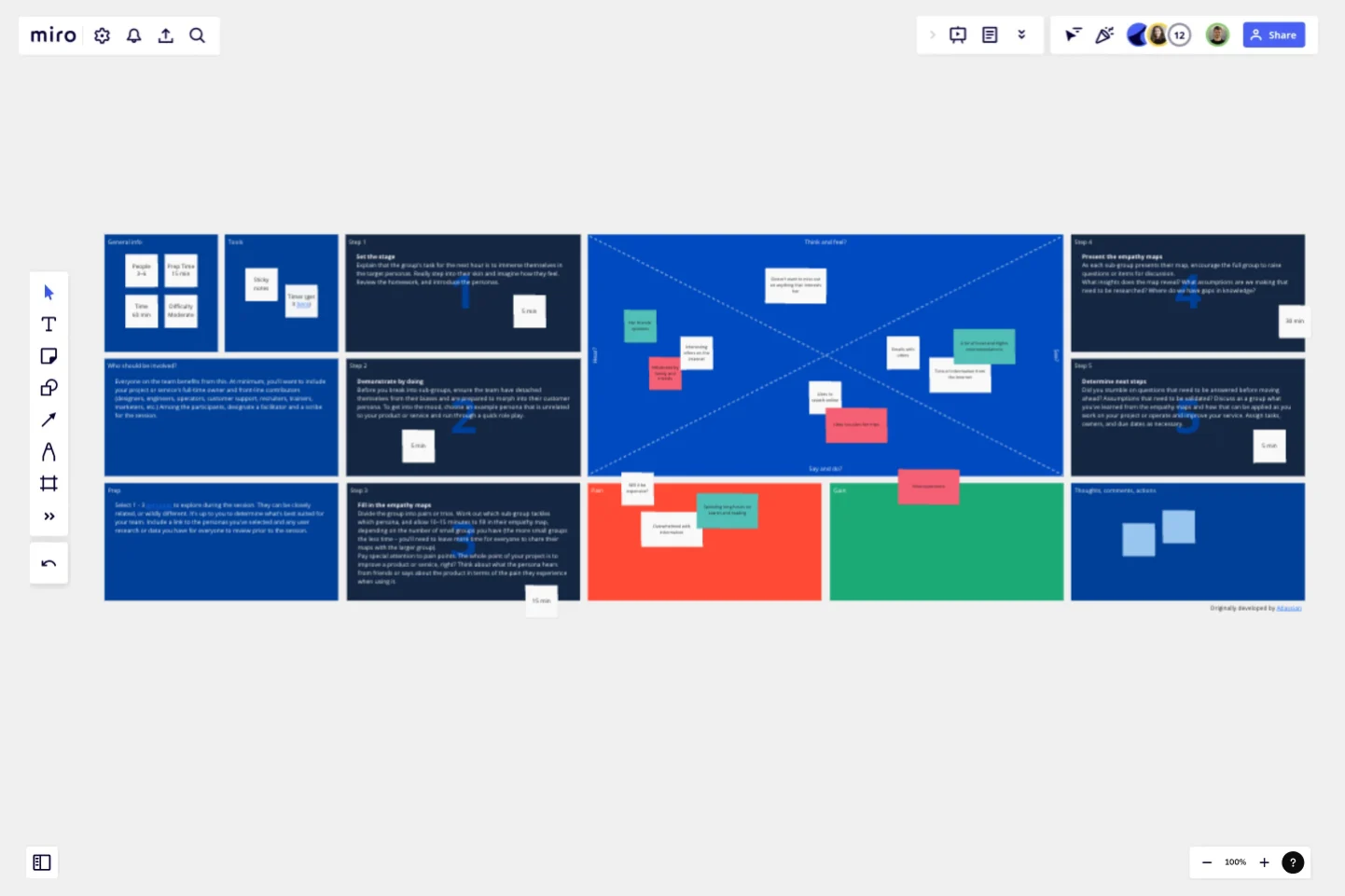Empathy Mapping by Atlassian
Follow these guidelines for Empathy Mapping.
Guidelines for Empathy Mapping
Step 1: Set the stage
5 min
Share 1-3 personas and any user research or data you have.Explain that the group's task for the next hour is to immerse themselves in the target personas. This isn't a sterile tick-the-box exercise you can sleepwalk your way through! Really step into their skin and imagine how they feel.
Step 2: Demonstrate by doing
5 min
Before you break into sub-groups, ensure the team have detached themselves from their biases and are prepared to morph into their customer persona. To get into the mood, choose an example persona that is unrelated to your product or service and run through a quick role play.For example, you could choose "a 42-year old who likes breakfast cereal" and walk through the sections of the empathy map.
Step 3: Fill in the empathy maps
15 min
Divide the group into pairs or trios. Work out which sub-group tackles which persona, and allow 10-15 minutes to fill in their empathy map.Remember, you can create empathy maps for an existing product to better understand how your personas feel about it right now. Or, you can create the map with a new design in mind to help articulate how you want customers to feel about it in its future state.Pay special attention to pain points. Think about what the persona hears from friends or says about the product in terms of the pain they experience when using it.
Step 4: Present the empathy maps
30 min
As each sub-group presents their map, encourage the full group to raise questions or items for discussion.What insights does the map reveal? What assumptions are we making that need to be researched? Where do we have gaps in knowledge?
Step 5: Determine next steps
5 min
Did you stumble on questions that need to be answered before moving ahead? Assumptions that need to be validated? Discuss as a group what you've learned from the empathy maps and how that can be applied as you work on your project or operate and improve your service.Assign tasks, owners, and due dates as necessary.
This template was created by Atlassian.
Get started with this template right now.
Empathy Mapping for Impact
Works best for:
Market Research, Research & Design
Empathy Mapping For Impact template is designed to help you capture and understand user experiences deeply. By focusing on what users think, feel, and do, you can create impactful and meaningful products. Perfect for UX designers and researchers.
Product Development Roadmap Template
Works best for:
Product Management, Software Development
Product development roadmaps cover everything your team needs to achieve when delivering a product from concept to market launch. Your product development roadmap is also a team alignment tool that offers guidance and leadership to help your team focus on balancing product innovation and meeting your customer’s needs. Investing time in creating a roadmap focused on your product development phases helps your team communicate a vision to business leaders, designers, developers, project managers, marketers, and anyone else who influences meeting team goals.
Official 5-Day Design Sprint
Works best for:
Design, Desk Research, Sprint Planning
The goal of a Design Sprint is to build and test a prototype in just five days. You'll take a small team, clear the schedule for a week, and rapidly progress from problem to tested solution using a proven step-by-step checklist. Steph Cruchon of Design Sprint created this template for Miro in collaboration with design sprint gurus at Google. This Design Sprint template is designed specifically for remote sprints so you can run productive and efficient sprints with colleagues around the world.
Service Blueprint by Daily Creations
Works best for:
Research & Design
Enhance your service design with the Service Blueprint template. This tool maps out the customer journey and backstage processes, helping you visualize and improve service delivery. It's perfect for aligning teams, identifying inefficiencies, and ensuring a seamless customer experience. Use this template to create a detailed roadmap of your service processes, fostering collaboration and strategic improvements in service design.
Idea Drafting Template
The Idea Drafting Template encourages you to tap into your innate creativity by drawing pictures to quickly generate ideas. The sketching process stimulates a cycle of creativity that supports the development of concepts. By externalizing your thoughts through sketches and seeing them visualized, you can generate variations and continue the creative process.
Mobile App Wireframe Template
Works best for:
UX, Wireframes, Mobile App Wireframe
The Mobile App Wireframe template helps you take your ideation game to the next level. Built to support UX teams, it enables you to craft impactful low-fidelity wireframes that serve as the foundation for your mobile app designs. Once you’ve completed the basic framework, you can seamlessly transform your wireframes into mockups, applying your selected theme with just one click.
